Is Reading Eggs all it’s cracked up to be? (boom tish)
22 Replies
After my last blog post about the new Reading Eggs – Fast Phonics program, its activity that looked exactly like a Nessy activity suddenly got new graphics. Then someone asked me why I’m not a fan of the original Reading Eggs program when it includes a lot of phonics, so I decided to take another look.
With hundreds of new COVID-19 cases daily (yeek) and a new face-masks-in-public rule, my state is heading back into another protracted period of home-based learning, probably including lots of e-learning. I want children to use programs that maximise their chances of successfully learning to read and spell.
Is Reading Eggs from the ABC?
I used to think that Reading Eggs was owned by the Australian Broadcasting Commission, because it uses the ABC logo.
Incorrect. Reading Eggs is owned by a company called Blake e-learning. It uses the trusted ABC name and logo in Australia under a retail partnership with ABC Commercial. The Reading Eggs site visible outside Australia, https://readingeggs.com, has no ABC logo (it quickly redirects Australians to the Australian site).
The ABC Commercial website says, “As an iconic, trusted brand, we are the only Australian distributor equipped to maximise the rights and opportunities across all product categories to help drive your business.” As a member of Friends of the ABC I was pretty surprised at that.
How should early reading and spelling be taught?
Beginning readers/spellers need be told from the very start that spoken words are made of sounds, which we write with letters. This seems obvious to literate adults, but is not at all obvious to young children, or many older learners. I once told a smart, illiterate teenager who’d had ten years of Australian schooling this fact, and he asked: “Why didn’t anyone tell me that?” (if you don’t know why, read journalist Emily Hanford’s reports or watch/listen to her recent PATTAN network talk here).
The sounds in our speech are invisible, quick and smoosh into each other, so splitting them up in order to spell them is hard. English is a mishmash of languages, warped over time (the wonderfully nerdy History of English podcast has details), so our writing system relates 44 speech sounds to 26 letters using five different types of logic:
- One sound can be written with one letter.
- One sound can be written with two, three or four letters e.g. sh, ou, dge, augh.
- Most sounds are written more than one way e.g. out, cow, drought.
- Some spellings represent more than one sound e.g. out, you, touch, cough, soul.
- Meaningful parts used to build longer words often have special spellings e.g. er, ed, ly, al, est, ous, chron.
Reading and spelling software for young beginners should stick to the simplest logic (#1). It should focus on teaching children to break up spoken words into sounds and write them with letters, and read words by saying a sound for each letter then blending the sounds together.
Like all good systematic, explicit, synthetic phonics programs (see examples) this software should start with just three to five sounds, represent them with single letters, and teach kids to use them to spell and read little words e.g. am, at, it, sat, sit, sis, mat and perhaps names like Sam, Sim, Tam and Tim.
Note that the words “is” and “as” don’t follow logic #1, as their last sound is /z/ (logic #4). Including them might confuse some children and undermine logic #1, so if they’re included they should be explained e.g. “at the end of words we often say /z/ for this letter”.
Extra sounds and their spellings should then be gradually, explicitly, systematically introduced and practised to mastery in short words (two or three sounds). Words can then be made longer e.g. with two consonants together as in “clip” and “tent”, then three as in “split” and “helps”, as consonant combinations can be quite hard to segment and blend.
This gives beginners a solid foundation for learning the additional sounds and remaining logic and patterns of our complex spelling system.
How does Reading Eggs stack up?
Reading Eggs offers a free trial period, so anyone can sign in and see the following things for themselves. It first introduces “the sound m, like in mouse” and presents the lower case letter m for children to click on to hear /m/ (I’ll put sounds in slash marks). There’s just letter m at first, and then children must discriminate it from two other letters. There’s no need to link sounds and letters in this activity, so it can be done using visual memory (not the kind of memory used in reading, see this blog post).
The program then asks “which picture starts with the /m/ sound?” and there are two pictures on screens e.g. “moss” and “sat”. I pretended to be a child without any awareness of sounds in words, and answered randomly. When I got it wrong, there was a “boing” sound with zigzags on the screens and I was told to “try again”. When I got it right, a cartoon character said a (less interesting) “yes”. No matter how many times I got it wrong, no help was offered. Eventually, thanks to having a 50-50 chance, I fluked it and went up to the next level.
I was then asked to “find /m/ in these words”, and printed words containing the letter “m” appeared the screen, but the words were not spoken, so again visual memory was all I needed. The words included digraphs (“moon”), split vowel digraphs (“time”) and two-syllable words (“metal”), examples of spelling logic #2 and #4.
When I clicked randomly I was told to “try again” till I eventually fluked enough correct answers. There was a song about words with “m” in them. The words flashed on screens with the letter m in a contrasting colour. To preliterate children, they probably look like chicken scratchings.
Next I was told to “complete the dot to dot to make the letter”, and there were numbered dots on the screen in roughly this layout:

I pretended I hadn’t learnt my numbers yet, and clicked randomly. I got three “boing” sounds and three red crosses on the screen, and then was asked “again?”. This happened no matter how many times I got it wrong. When I clicked on the dots in numerical order, the lower case letter “m” was filled in between the dots, and I was asked to do it faster. I hope a handwriting expert can tell us in the comments whether this sort of numbered-dot-clicking is a good way to teach early letter formation.
Next came a 6×6 letter grid with six copies of the letter “m” in it, in slightly different fonts, and including visually similar letters like “n”, “h” and “w”. I was told to click on /m/. When I made mistakes I got red crosses and “boing” sounds, and after three errors was asked “again?”, but the game did not adjust to my confusion by reducing the number of choices, providing hints or otherwise helping me.
I was then shown a letter “m” and told “This is the letter em, it makes the sound /m/’. Capital em looks like this (M), it also makes the sound /m/”. Preliterate me wondered why we have two letters for the same sound, but this wasn’t explained. A 6X6 grid like the previous one appeared, this time with capital letters, and again if I couldn’t find the M’s, the task was not simplified, I just went round and round being asked “again?” till I fluked it.
Next I was shown a letter “m” in a book and asked to click on the picture that begins with /m/. With only two pictures presented at a time, I had a 50-50 chance. The picture names were not spoken unless I clicked on the speakers next to them, and when I made three mistakes I had to go back to the start. There was no slowing down or stretching out of spoken words, or other explicit assistance with making the connection between the sound in words and the letter.
Next I was shown a screen arranged like this, and asked to drag the words to the pictures:
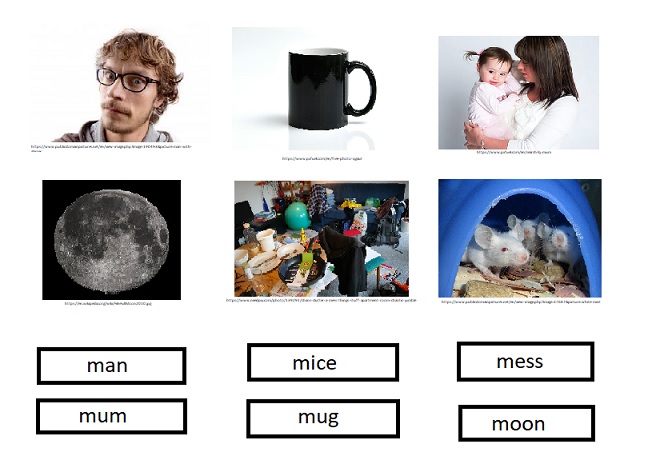
So far in this program kids have only learnt one letter, so can’t read the words, but that doesn’t matter because you just click on the words and they’re spoken, so all you need to do is match spoken words to pictures. You can just ignore the written words, and since reading them requires logic #2 (moon, mess, mice) and #3 (/s/ as in mess, mice), probably that’s a good thing.
Next there was a book with a different word starting with “m” on each page, including words with vowel and consonant digraphs, consonant blends and two syllables, and a total of 15 different sound-spelling relationships, some based on logic #2 (ey as in monkey and money, oo as in moon, ou and se as in mouse) and logic #4 (o as in money, monkey, mop; n as in man, monkey).
This type of book teaches preliterate kids to “read” by looking at first letters, pictures and guessing words. This is reading-like behaviour, but should never be confused with reading. So far only one sound has been taught, so kids aren’t yet equipped to start reading.
Next, the sound /s/ and letter “s” are introduced in much the same format. There is letter identification and matching, spoken word to picture matching (including the three-syllable word “spaghetti”), and a book about “s” with 23 different sound-spelling relationships involving logic #1, #2, #3 and #4.
In the third level I am invited to “Click on the word I” (my italics) and the capital letter “I” appears, first by itself and then with two other capital letters. Then I’m told I’ll be shown “the sound ‘am’ like in ‘clam'” (my italics). So this activity introduces two extra levels of word analysis – rimes (mislabeled sounds) and whole words. Preliterate me wondered why “I” is called a word, when it has only one letter, while “am” is called a sound, when it has two letters.
Next I was told to click on “am”, first by itself and then with distractor items like “xi” and “lu” on bowls of sugar cubes (Reading Eggs has also offered me cakes and marshmallows, so it’s not from the I Quit Sugar brigade).
Then I am asked to “click on the picture which has the am sound in it”, and pictures offered include “dam”, “ham” (which lots of people don’t eat), “lamb” and “stamp” (the latter being especially hard for little kids to discern the “am sound” in, as it’s not at the start or end of the word).
Then I’m shown the sentence “I am Sam” and asked to click on each word, after which the words are scrambled and I am asked to click on them again. Then I’m asked to “complete the dot to dot to make the letter”, though it doesn’t say which letter. It turns out to be a capital I. Preliterate me wonders why they’re now calling it a letter, not a word.

So far, Reading Eggs seems to be a mixture of initial, letter-of-the-week type phonics, picture-guessing and memorising whole words. In the next activity I’m asked to “say each sound and make the word” and shown how to blend “a” and “m” into “am”. This happens once only, and then I’m told “now it’s your turn”, and the visuals repeat, but not the sounds. The same thing happens for the word “Sam”. Then “a” and “s” (/s/) are blended to make “as” pronounced /az/. Nobody explains the sound change.
Next, lower case letter i is given its letter name (“I”), which you’ll recall was earlier taught as the “word” for upper case letter I. I’m asked to find six of them in a grid, but when I get to the grid I’m told to “click on /i/” (the “short” sound).
Sorry, but I really can’t justify spending any more of my time looking at a program that I am not going to recommend to anyone.
If you’d like my recommendations for early literacy iPad apps for little kids, see this blog post. Several of them have versions on other platforms, including Graphogame, Phonics Hero, Nessy and Reading Doctor.
Top early literacy apps 2020
32 Replies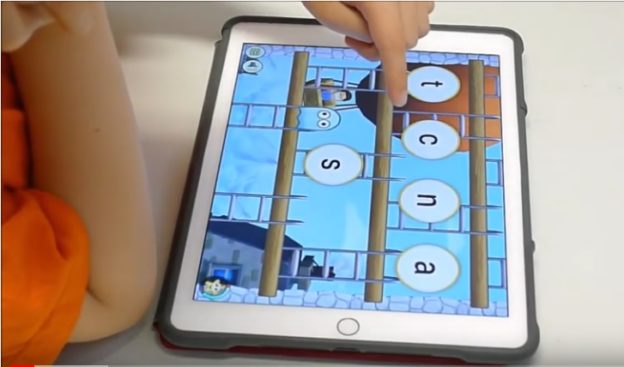
Most young children are already using apps on phones or tablets, at least occasionally. Whatever you think of kids’ screen time, we want it to be quality time. There is some evidence that interactive apps support early academic development, but finding quality early literacy apps can be difficult and time-consuming. Lots of what’s available is (IMHO) simply rubbish.
It’s helpful to read adult reviews of apps for children, but a lot of online information is available about them already, and to REALLY road-test an app, I like to watch a young child using it. My colleague Caitlin Stephenson and I have thus filmed Harrison (aged 4, nearly 5) trying out some of my favourite early phonemic awareness and phonics iPad apps for young children.
The resulting video is below. We hope it gives you a taste of how each app works, to help you decide whether it would suit the small person/people in your life. The video is 16 minutes long, and the apps tried are listed below (numbers in brackets are start times on the video clock):
- Graphogame (0:06)
- Phonics Hero (1:50)
- Hairy Letters from Nessy (3:26)
- Bob Books Reading Magic 1 (5:00)
- Reading Raven (6:25)
- Reading Doctor Letter Sounds 1 Pro (8:32)
- Cake Shop Letters (or if you prefer, Spooky Letters or Dinosaur Letters) (10:10)
- Initial Code from Sounds-Write (full version is here) (11:37)
- Wordchain 1 (13:04) which is the original NZ version, there is now also an Australian accent single-user version, and multi-user version.
- Phonics Read CVC 100 Words by Joe Scrivens (14:36, note he was pretty tired by then)
The only tablet I have is an iPad, but some of these apps are available for other platforms. Many also work on iPhones. If you’re not in Australia, please note that my app store links are all to the Australian store, so you’ll have to search your local store for apps that take your fancy.
I’m not quoting prices here because they often change, and things that I’ve said are free suddenly aren’t, while things I’ve said are expensive drop in price. Also, some apps have hundreds of activities, while some have only one/a few, so it’s like comparing apples and banquets. I’ve decided to leave the value-for-money question up to you.
Other early literacy iPad apps IMHO worth considering for young children include:
- Alphablocks Letter Fun and Meet the Alphablocks
- Atlas Mission
- CVC Word Sort
- CVC Words Short Vowel Phonics
- Hear and Blend the Alphabet
- Jolly Phonics Letter Sounds (for Android here) & Jolly Phonics Fun
- Let’s Read 1: Sounds, Let’s Read 1: Spelling and Let’s Read 1: Words.
- Little Speller & Little Reader – Three Letter Words (turn off Mixed Words and set word length to only 3 letters in the menu for beginners).
- Making Words Kindergarten and First Grade
- Maria – Learn To Read
- Oz Phonics Reading Intro, 1 & 2
- Phonics Bingo, CVC Phonics Spelling Practice & Train Phonics (Joe Scrivens’ Phonics Bundle)
- Phonics Flashcards & I Can Spell With Phonics
- PLD Reading Race 1a & Spellstar 1a
- Pocket Phonics
- Reading Magic 1 & Spelling Magic 1 (and other Preschool University apps)
- Ready, Set, Read
- Read With Phonics
- Starfall Learn To Read
- Teach Your Monster To Read
- What’s Changed?
- Word Sounds/Phonemes
- Word Wizard for Kids, also for Android
Beginners’ decodable books allow children to practice phonics skills by reading stories containing simplified spelling patterns, and some of these are also available as apps:
- Decodable Readers Australia
- Fitzroy Readers 1-10, also available for Android
- Little Learners Love Literacy
- Pocket Phonics Stories
- Quackenworth Vowel Stories
Apologies to all the people who make good apps of which I’m not aware. I’d love to hear about them, and wish I had more time to search for and try them.
I hope this blog post helps you find apps that the small people in your life enjoy, and which help them develop great early literacy skills.
Free downloadable phonics card game
8 Replies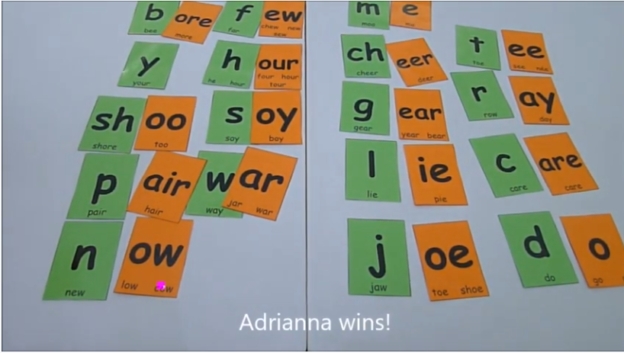
These days we all have the attention span of a gnat, so here’s a new, 60-second video about a simpler, faster way to play my free Twender word-building card game:
Setup:
- Download the game from https://www.spelfabet.com.au/materials/level-5-twender-game-comic-sans-font
- Print the consonant cards in one colour and the vowel cards in a different colour.
- Ignore the original instructions, or try playing both ways.
Play:
- Deal the two sets of cards equally.
- Race to make words with all your cards. The winner is the person who uses all their cards up first, or if nobody can do this, the person who makes the most words.
Happy New Year from all of us at Spelfabet!
Another 12 decks of vowel-focussed playing cards
2 Replies
Just in time for our thank-goodness-winter-is-over school holidays, here’s a dozen more vowel-sound-focussed playing card decks, including two freebies, to download and print.
These decks are a little more advanced than the previous ones available here, here and here. They reflect the teaching sequence used in the Phonic Books Talisman 1/Rescue Series and the Sounds-Write program‘s Extended Code section and books, but can be used with other synthetic phonics teaching sequences and programs.
The decks work from sound to print, and focus on the following sound-spelling relationships:
- /ay/ as in “mistake”, “contain”, “holiday”, “navy”, “obey” and “great”.
- /ee/ as in “coffee”, “disease”, “secret”, “carry”, “believe”, “protein” and “compete”.
- /oe/ as in “remote”, “roast”, “follow”, “hero” and “mangoes”.
- /er/ as in “swerve”, “circle”, “burnt”, “search” and “worth”.
- /ou/ as in “aloud” and “trowel”, and /oy/ as in “point” and “destroy”.
- /oo/ as in “smooth”, “rule”, “true”, “fluid”, “jewel” and “group”.
- /igh/ as in “delight”, “despite”, “crisis”, “apply” and “allies”.
- /or/ as in “porch”, “before” and “drawn”.
- /or/ as in “stall”, “chalk”, “brought”, “daughter”, “author” and “warm” (there were so many spellings of this sound they wouldn’t fit in a single deck).
- /air/ as in “chair”, “declare”, “bear”, “where” and “their”.
- /ar/ as in “charm”, “past”, “calm”, “heart” and “aunt”.
- One deck of high-frequency words with a mixture of the above sound-spelling relationships (not available separately, but included to bring this set up to a dozen decks).
The decks can be downloaded individually (starting from the third item here) or as a discounted bundle of 12. We suggest printing the cards on A4 200gsm cardboard, available from major stationery shops, which can be used in most printers/photocopiers.
If you plan to use the cards a lot, we suggest laminating them, though this is not essential if you’d rather not add to the planetary plastic overload. We recommend that children be encouraged to practise their scissor skills by cutting them up, rounding the corners if a more professional look is sought.
All the decks can be used for any card game requiring a standard deck of cards, from very simple games of chance like War to complex strategic ones like Mancala. See this previous blog post for videos of other suggested games.
We hope these cards give many children many hours of well-targeted, high-intensity repeated reading practice, cleverly disguised as fun. Thanks once again to Caitlin Stephenson for the original idea and design.
New and improved phonics playing cards
5 Replies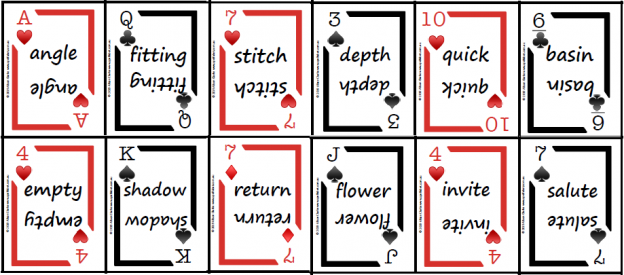
There’s a new set of downloadable phonics playing cards in the Spelfabet shop, including a couple of free decks. These add a few new sound-spelling relationships and syllable types as well as mixing and reviewing patterns covered earlier. Spaced practice, people.
The sequence broadly matches the Phonic Books (last bit of Magic Belt/That Dog, and most of Alba/Totem) and Sounds-Write teaching sequence, but the cards should be able to be used with most other phonics teaching sequences. All four of us at Spelfabet have done some work on these, after Caitlin Stephenson had the original idea.
Use these cards to play any of the games shown in videos in this previous blog post, or any other game you like requiring a standard deck of playing cards. (more…)
We need GOOD practice, not common practice
15 Replies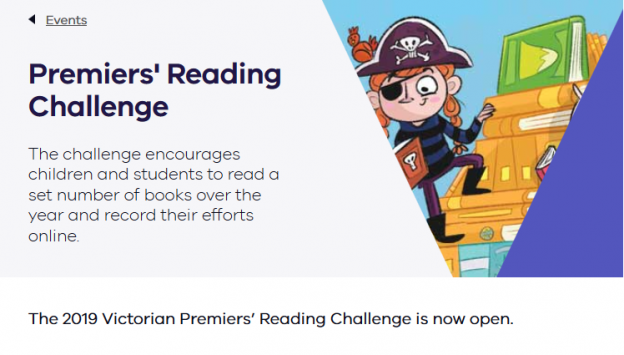
I wrote an opinion piece in The Age newspaper this week called “Premiers’ Reading Challenge no fun for kids who can’t read“, arguing we need to close the gap between research and practice in early literacy education, so more kids can enjoy, not dread, the Premiers’ Reading Challenge.
I hope it’s helped put another nail in the coffin of common, but extremely poor, literacy-teaching practices like rote wordlist-memorisation (the “magic words” etc) without regard to their structure, incidental-not-systematic phonics, and encouraging kids to guess words from first letter, sentence structure and context/pictures.
I hope it also helps kill off the idea that reading is natural, and replace educational blah-blah about reader identity and teacher literacy philosophy with more interesting discussions about what science tells us about how to best teach reading.
I’m sorry they didn’t include my link to Emily Hanford’s great “Hard Words: why aren’t kids being taught to read” audio documentary, but otherwise happy with it, especially the mention of David Kilpatrick’s seminar on 19 August at Melbourne Town Hall (have you signed up yet? He will also speak in Perth and Cairns, and Sydney and Adelaide, but they’re booked out).
Of course letters to the editor appeared the next day disagreeing with me. People who agree with something they read in the paper don’t generally rush to write to the editor. Editors don’t usually give a right of reply to these letters, so I’m giving myself one here. (more…)
Introducing Clever Caitlin’s phonics playing cards
14 Replies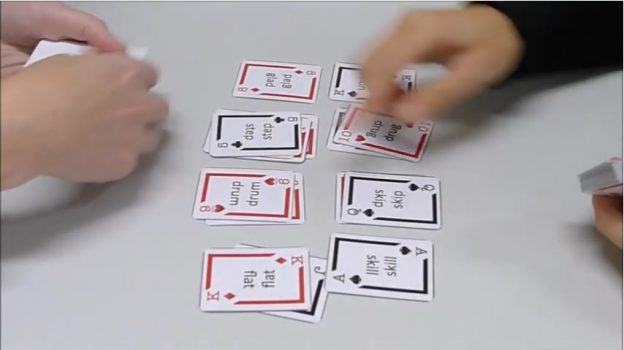
This year I have some excellent new colleagues, and one of them, Caitlin Stephenson, is queen of making therapy fun for kids.
She grew up playing cards with abundant siblings, and came up with the idea of phonics playing cards.
For an affordable, fun, social, portable phonics activity that can be tailored to a range of ages and abilities, they’re hard to beat.
Caitlin and I have so far collaborated to create over 50 decks of downloadable phonics playing cards, and so far I’ve put 30 of them in the Spelfabet shop. (April 2020 update: there are now 57 decks in the shop, I’m about to add another dozen, and there are still a few more to come). (more…)


